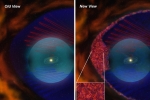How Methane-Producing Microbes Caused The Largest Mass Extinction The World Has Ever Seen

About 250 million years ago, nearly all life on Earth suddenly died. One expert believes the die-off — which killed 90 percent of all species and is known as the end-Permian extinction event — happened over the course of just 100,000 years. But until now, most hypotheses about what caused it have seemed like pure speculation: asteroids, volcanoes, and massive coal fires among them.
Like Us on Facebook
A new theory, published Monday in Proceedings of the National Academy of Sciences, offers a different conclusion. And it's one most people have some familiarity with: climate change caused by greenhouse gases. Without humans around to spur it on, however, the scientists behind the research (from the Massachusetts Institute of Technology and the Chinese Academy of Sciences in Nanjing) needed a new culprit. They found their suspect in tiny microbes called Methanosarcina. Through metabolism, these microscopic organisms emit enormous amounts of methane, which is extremely effective at trapping heat in the atmosphere.
Microbes explain a lot because other theories never quite answered all the questions. An asteroid collision is probably the cause of the global calamity that killed the dinosaurs 65 million years ago because the sediment layer from that time is full of asteroid dust. But rocks from the end of the Permian era are not.
The volcano theory is a good one — almost. Around 250 million years ago, Siberia was a raging volcano, spewing lava and debris for thousands of miles. Carbon emissions from that could have caused a dramatic climate change. But calculations by the MIT researchers found that the amount of carbon released just wasn't enough. Plus, "a rapid initial injection of carbon dioxide from a volcano would be followed by a gradual decrease," says Gregory Fournier, of MIT, in a statement. "Instead, we see the opposite: a rapid, continuing increase."
(The scientists don't really address the coal fire theory, which gained prominence in 2011. The lead geologist on a study at that time called it a "literal smoking gun.")
In any case, Fournier and his colleagues believe the methane-making-microbe theory is the most convincing because of three key pieces of evidence, almost like a chain of events. One is a hyper-exponential increase in inorganic carbon in the world's oceans. It doesn't get there from nothing: microbes create it. But under normal circumstances, nothing even these microbes couldn't have caused so much of it to form so quickly. Turns out these Methanosarcina underwent a genetic transformation right around 250 million years ago that allowed them to convert even more carbon to methane.
The third piece of evidence circles back to those Siberian volcanoes that were spouting at the time. While their carbon emissions have been deemed harmless, their production of another element, nickel, may have had a role to play. These microbes need nickel as a nutrient; without it they couldn't have proliferated like the scientists say they did. "That provided the fuel for Methanosarcina's explosive growth," MIT reported.
"The cumulative impact of all these things is much more powerful than any one individually," says Daniel H. Rothman, a co-author of the study. Once the carbon cylcle got off kilter, the microbes took it from there. It was a runaway greenhouse effect that warmed the Earth until most animals couldn't handle it anymore. He says that, taken together, all the evidence provides a "strong and consistent case."
Above image courtesy of Shutterstock
© 2012 iScience Times All rights reserved. Do not reproduce without permission.

25 Year Study Reveals Eco-Farming To Be Economically Feasible And Sustainable

How Methane-Producing Microbes Caused The Largest Mass Extinction The World Has Ever Seen

Terrifying Animatronic Robot Dances To 'Blurred Lines,' Causes Nightmares [VIDEO]

Scientists Demonstrate Three-Way Quantum Communication: What's Faster Than The Speed Of Light?

Woolly Mammoth DNA To Be Cloned, Then Joined With Elephant DNA To Create New Creature

Oculus Rift Headset Will Take You On A Trip To Space, All From The Comfort Of Your Couch



![How to Turn Your Tap Water Faucet Into a Coffee Spout [VIDEO]](../../../cdn-sub/data/thumb/mainpage/6005-150100-coffee.jpg)

